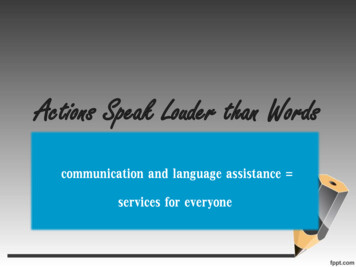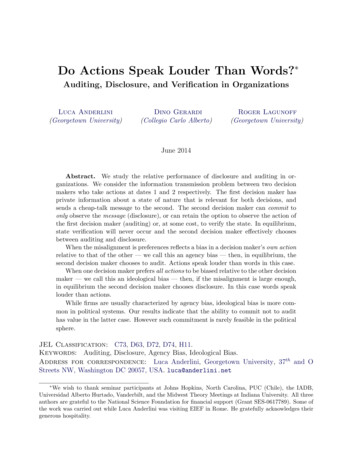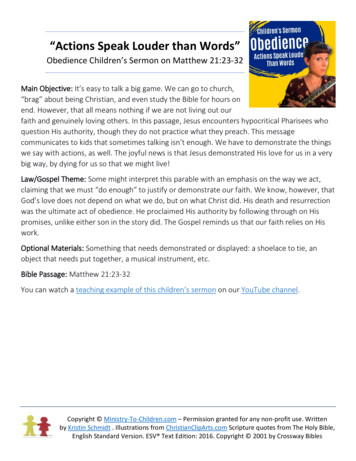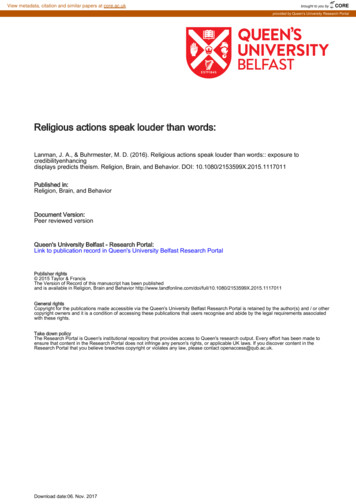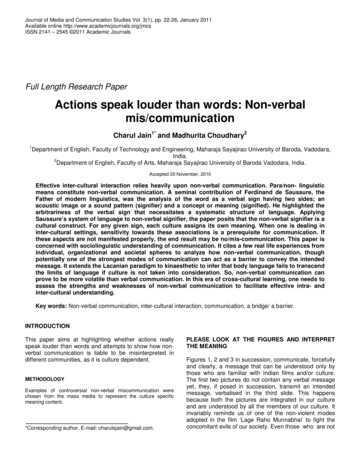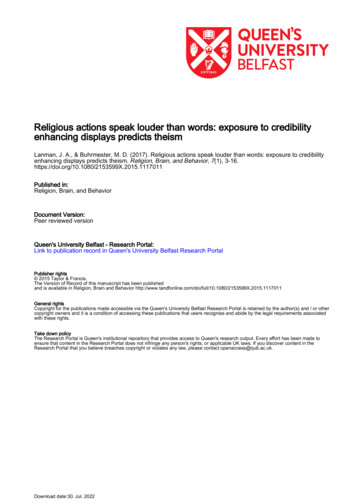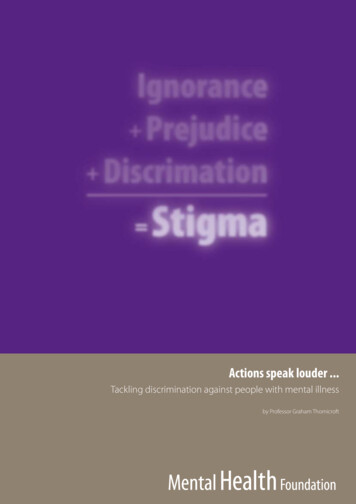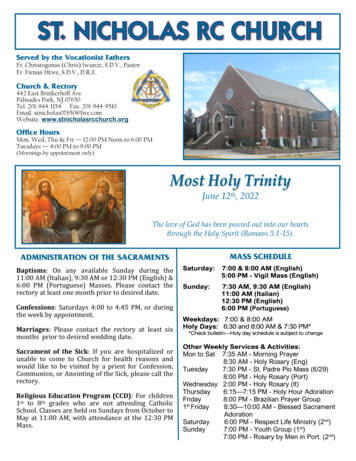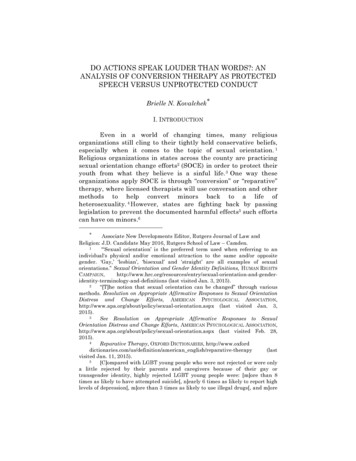
Transcription
DO ACTIONS SPEAK LOUDER THAN WORDS?: ANANALYSIS OF CONVERSION THERAPY AS PROTECTEDSPEECH VERSUS UNPROTECTED CONDUCTBrielle N. Kovalchek*I. INTRODUCTIONEven in a world of changing times, many religiousorganizations still cling to their tightly held conservative beliefs,especially when it comes to the topic of sexual orientation. 1Religious organizations in states across the county are practicingsexual orientation change efforts2 (SOCE) in order to protect theiryouth from what they believe is a sinful life. 3 One way theseorganizations apply SOCE is through “conversion” or “reparative”therapy, where licensed therapists will use conversation and othermethods to help convert minors back to a life ofheterosexuality. 4 However, states are fighting back by passinglegislation to prevent the documented harmful effects5 such effortscan have on minors.6*Associate New Developments Editor, Rutgers Journal of Law andReligion: J.D. Candidate May 2016, Rutgers School of Law – Camden.1“‘Sexual orientation’ is the preferred term used when referring to anindividual's physical and/or emotional attraction to the same and/or oppositegender. ‘Gay,’ ‘lesbian’, ‘bisexual’ and ‘straight’ are all examples of sexualorientations.” Sexual Orientation and Gender Identity Definitions, HUMAN and-definitions (last visited Jan. 3, 2015).2“[T]he notion that sexual orientation can be changed” through variousmethods. Resolution on Appropriate Affirmative Responses to Sexual OrientationDistress and Change Efforts, AMERICAN PSYCHOLOGICAL -orientation.aspx (last visited Jan. 3,2015).3See Resolution on Appropriate Affirmative Responses to SexualOrientation Distress and Change Efforts, AMERICAN PSYCHOLOGICAL -orientation.aspx (last visited Feb. 28,2015).4Reparative Therapy, OXFORD DICTIONARIES, erican english/reparative-therapy(lastvisited Jan. 11, 2015).5[C]ompared with LGBT young people who were not rejected or were onlya little rejected by their parents and caregivers because of their gay ortransgender identity, highly rejected LGBT young people were: [m]ore than 8times as likely to have attempted suicide[, n]early 6 times as likely to report highlevels of depression[, m]ore than 3 times as likely to use illegal drugs[, and m]ore
2015]DO ACTIONS SPEAK LOUDER THAN WORDS?429For example, two states that have passed SOCE legislationare California and New Jersey.7 In 2012, California passed SenateBill No. 1172,8 while in 2013, New Jersey passed Assembly BillA3371.9 Both laws deal with protecting minors against SOCE andboth inevitably lead to issues needing to be resolved in court.10 Inboth the California case of Pickup v. Brown,11 and the New Jerseycase of King v. Governor of New Jersey,12 plaintiffs argued thatusing conversation or “talk therapy” as a method of SOCE wasentitled to free speech and free exercise protection 13 under theFirst Amendment14 and thus, plaintiffs felt that both SB 1172 andA 3371 were unconstitutional. While both the Ninth Circuit inPickup and the Third Circuit in King disagreed with plaintiffs andupheld both legislations, the Circuits differed as to whether or not“talk therapy” was considered protected free speech or simplyconduct.15Therefore, this article will first look at a brief history ofsexual orientation change efforts and how religious organizationsuse them today. Next, this article will analyze the decisions inboth Pickup v. Brown and King v. Governor of New Jersey, as wellas look at the California and New Jersey SOCE laws prevalent ineach case. Lastly this article will consider and analyze, based onboth cases, what standard of review should be used and whether ornot “talk therapy” should be protected under the First Amendmentthan 3 times as likely to be at high risk for HIV and STDs. The Lies and Dangersof Efforts to Change Sexual Orientation or Gender Identity, HUMAN RIGHTSCAMPAIGN, ngers-of-reparativetherapy (last visited Jan. 3, 2015).6Peter Sprigg, Protect Client and Therapist Freedom of Choice ARCHCOUNCIL,http://www.frc.org/socetherapybans (last visited Jan. 3, 2015).7Id.8Pickup v. Brown, 728 F.3d 1042, 1050 (9th Cir. 2013).9King v. Governor of N.J., 767 F.3d 216, 221 (3d Cir. 2014).10Pickup, 728 F.3d at 1048; King, 767 F.3d at 220.11Pickup, 728 F.3d at 1042.12King, 767 F.3d at 216.13Pickup, 728 F.3d at 1051; King, 767 F.3d at 222.14“Congress shall make no law respecting an establishment of religion, orprohibiting the free exercise thereof; or abridging the freedom of speech, or of thepress; or the right of the people peaceably to assemble, and to petition thegovernment for a redress of grievances.” U.S. CONST. amend. I.15King, 767 F.3d at 229; Pickup, 728 F.3d at 1055.
430RUTGERS JOURNAL OF LAW & RELIGION[Vol. 16or whether it should be treated solely as conduct, thereforewarranting no constitutional protection.II. SEXUAL ORIENTATION CHANGE EFFORTSSexual Orientation Change Efforts attempt to rid minors ofhomosexual attraction while also attempting to cultivateheterosexual attraction in the patients being treated. 16 Suchpractices have been around for over a century.17 One of the mainreasons for the start of SOCE was the belief that homosexualitywas either a crime or a medical disease.18 In fact it was not until1973 that the American Psychiatric Association (APA) decided toremove homosexuality from its Diagnostic and Statistical Manualof Mental Disorders. 19 Nevertheless—even after 1973—manyphysiologists, especially those affiliated with conservative religiousorganizations, still carry the belief that homosexuality issomething that can be cured.20In attempts to free individuals of homosexual thoughts andbehaviors, therapists have conducted a plethora of methods overtime.21 Such tactics include “psychoanalytic therapy, prayer andspiritual intervention, electric shock, nausea-inducing drugs,hormone therapy, surgery and various adjunctive behaviortreatments, including masturbatory reconditioning, rest, visits toprostitutes, and excessive bicycle riding.”22 While many of thesepractices include physical intrusions on patients, one common nonphysical practice used is that of “talk therapy.”23Jacob Victor, Note, Regulating Sexual Orientation Change Efforts: TheCalifornia Approach, Its Limitations, and Potential Alternatives, 123 YALE L.J.1532, 1534 (2014).17Jonathan Sacks, Note, “Pray Away the Gay?” An Analysis of the Legalityof Conversion Therapy By Homophobic Religious Organizations, 13 RUTGERS J.L.& RELIGION 67, 72 (2011).18Appropriate Therapeutic Responses to Sexual Orientation, 21 eutic-response.pdf.19Sacks, supra note 17, at 72–73.20Victor, supra note 16, at 1534–35.21Douglas C. Halderman, The Practice and Ethics of Sexual OrientationConversion Therapy, 62 No. 2 J. OF CONSULTING AND CLINICAL PSYCHOLOGY 221(1994).22Id.23“Talking therapies can help [one] work out how to deal with negativethoughts and feelings and make positive changes. They can help people who arefeeling distressed by difficult events in their lives as well as people with a mentalhealthproblem.”Talking Therapies,MENTAL HEALTH FOUNDATION,16
2015]DO ACTIONS SPEAK LOUDER THAN WORDS?431Today, despite the growing acceptance of homosexuality24and the general movement away from SOCE, many psychologistsand therapists associated with religious organizations feel thatunder the First Amendment, talk therapy is a constitutional,perfectly legal, form of reparative therapy. 25 In fact, both theplaintiffs in Pickup and King, felt that under Freedom of Speech,26talk therapy should be protected because it is implemented “solelythrough verbal communication.”27 Therapists will begin SOCE bylooking to find the “root cause” of the homosexual behavior.28 Next,therapists attempt to convert the patient to heterosexuality bydiscussing “traditional, gender-appropriate behaviors andcharacteristics.” 29 Manycounselorsimplementbiblical30perspectives into their discussions. However, such therapiststend to ignore the harmful effects that can occur when sexualorientation change efforts are implemented.31Therefore, in order to study the effects of SOCE, the APAcreated a task force in 2007 to look into such matters. mental-health-a-z/t/talkingtherapies/ (last visited Jan. 5, 2015). Talk therapy as a method of SOCE involvesdiscussing homosexual behaviors in an attempt to “cure[ ]” patients. See Victor,supra note 16, at 1534.24“[P]ublic attitudes toward gays and lesbians are rapidly changing toreflect greater acceptance, with younger generations leading the way.” AmericansMove Dramatically Toward Acceptance of Homosexuality, NORC AT THEUNIVERSITY OF CHICAGO, gss-report.aspx(last visited Mar. 4, 2015).25King, 767 F.3d at 220–22.26“This clause prohibits the government from banning speech because itdoes not agree with the message. The Founders saw free speech as a naturalright.” First Amendment: Freedom of Speech (1791), BILL OF RIGHTS l-of-rights/first-amendment/freedom-of-speech/ (last visited Jan 5, 2015).27King, 767 F.3d at 220–21; See also Pickup, 728 F.3d at 1056 n.5.28King, 767 F.3d at 221.29Id.30Id.31Id. at 221–22.32In February 2007, the American Psychological Association (APA)established the Task Force on Appropriate Therapeutic Responses to SexualOrientation with a charge that included three major tasks: 1. Review and updatethe Resolution on Appropriate Therapeutic Responses to Sexual Orientation(APA, 1998). 2. Generate a report that includes discussion of the following:[ ] The appropriate application of affirmative therapeutic interventions forchildren and adolescents who present a desire to change either their sexual
432RUTGERS JOURNAL OF LAW & RELIGION[Vol. 16Ultimately, the task force concluded that SOCE was unlikely toincrease other-sex sexual behavior and that harm could resultfrom aversive efforts to change sexual orientation.33 Additionally,studies indicate “attempts to change sexual orientation may causeor exacerbate distress and poor mental health in some individuals,including depression and suicidal thoughts.” 34 Because of theseconclusions, it is no surprise that many states are seeking toprevent these potential harms, especially when it involves minors.III. SEXUAL ORIENTATION CHANGE EFFORTS CASE LAWA. Varying Degrees of Scrutiny and Free Speech35Free speech is protected under the First Amendment. 36Nevertheless, varying degrees of scrutiny are applied dependingon the degree of the wrongdoing.37 Rational basis scrutiny will beorientation or their behavioral expression of their sexual orientation, or both, orwhose guardian expresses a desire for the minor to change. [ ] The appropriateapplication of affirmative therapeutic interventions for adults who present adesire to change their sexual orientation or their behavioral expression of theirsexual orientation, or both. [ ] The presence of adolescent inpatient facilities thatoffer coercive treatment designed to change sexual orientation or the behavioralexpression of sexual orientation. [ ] Education, training and research issues asthey pertain to such therapeutic interventions. [ ] Recommendations regardingtreatment protocols that promote stereotyped gender-normative behavior tomitigate behaviors that are perceived to be indicators that a child will develop ahomosexual orientation in adolescence and adulthood. 3. Inform APA’s responseto groups that promote treatments to change sexual orientation or its behavioralexpression and support public policy that furthers affirmative therapeuticinterventions.Appropriate Therapeutic Responses to Sexual Orientation, 21 eutic-response.pdf.33Id. at 41.34Id. at 42.35It is important to note that the tiers of scrutiny were originally appliedin the Equal Protection context under the 14th Amendment. History of EqualProtection and the Levels of Review, NATIONAL PARALEGAL c p (last visited Jan. 30, 2015). However, SB 1172 and A3371are not looked at under the equal protection of a specific class of individuals suchas homosexuals. Rather, both laws deal with limiting the speech of state licensedtherapists. King, 767 F.3d at 224; Pickup, 728 F.3d 1050–51.36U.S. CONST. amend. 1.37Elizabeth Bookwalter, Getting it Straight: A First Amendment Analysisof California’s Ban on Sexual Orientation Change Efforts and Its Potential Effectson Abortion Regulations, 22 AM. U.J. GENDER SOC. POL’Y & L. 451, 460 (2014).
2015]DO ACTIONS SPEAK LOUDER THAN WORDS?433applied when “a state action, such as a law or professionalregulation, does not implicate any constitutional rights.” 38 Thestate law will be valid as long as the state has a legitimate basisfor taking such action and as long as the action is rationallyrelated to the state’s interest. 39 Intermediate scrutiny will beapplied when state action “implicates a fundamental right.”40 Withintermediate scrutiny, the state will win unless they fail to showthat the state action is narrowly tailored to serve a substantialgovernment interest.41 Lastly, strict scrutiny will be applied whenthe state action is content-based or viewpoint based. 42 Strictscrutiny is the most demanding level of review and can only beovercome if the state cannot prove “that the action addresses acompelling interest, that the state narrowly tailored the regulationto further its interest, and that the regulation is the leastrestrictive means of achieving that end.”43B. Pickup v. BrownOne of the first challenges to a legislative ban on talktherapy came in the case of Pickup v. Brown. 44 Pickup was aconsolidation of two separate cases: Welch v. Brown45 and Pickupv. Brown.46 In both cases, plaintiffs were mental health providersthat used non-aversive sexual orientation change efforts. 47Plaintiffs were challenging SB 1172, claiming a violation of theirFirst Amendment free speech protections, as well as a violation oftheir privacy rights.48 Plaintiffs also argued that the law violatedtheir Freedom of Religion49 and was unconstitutionally vague andoverbroad.50Id. at 461.Id.40Id.41Id.42Bookwalter, supra note 37, at 462.43Id.44See Pickup, 728 F.3d at 1048.45Welch v. Brown, 907 F. Supp. 2d 1102 (E.D. Cal. 2012).46Pickup, 728 F.3d at 1048.47Id. at 1049.48Id. at 1051.49“The First Amendment to the Constitution protects freedom of religionby banning Congress from passing any law respecting an establishment ofreligion and from prohibiting people from freely exercising their religion. TheSupreme Court has applied these limits to state governments through theFourteenth Amendment.” Freedom of Religion, BILL OF RIGHTS INSTITUTE,3839
434RUTGERS JOURNAL OF LAW & RELIGION[Vol. 16In short, SB 1172 prohibits SOCE efforts on patients underthe age of eighteen because it considers such practices“unprofessional conduct” subject to “discipline by the licensingentity for that mental health provider.”51 SB 1172 defined SOCEas “any practices by mental health providers that seek to changean individual's sexual orientation.”52 These practices would include“efforts to change behaviors or gender expressions, or to eliminateor reduce sexual or romantic attractions or feelings towardindividuals of the same sex.” 53 Ultimately, SB 1172 “requireslicensed mental health providers in California who wish to engagein ‘practices . . . that seek to change a [minor’s] sexual orientation’either to wait until the minor turns 18 or be subject to professionaldiscipline.”54 The legislative intent behind the bill was to “‘protect[] the physical and psychological well-being of minors, includinglesbian, gay, bisexual, and transgender youth, and [to] protect[ ]its minors against exposure to serious harms caused by sexualorientation change efforts.’”55 Nevertheless, the plaintiffs felt thatnot being able to engage is SOCE with minors was a violation oftheir constitutional rights.56Prior to reaching the Ninth Circuit, the Welch courtgranted the plaintiffs injunction for preliminary relief because itfelt that California was unlikely to meet its burden and plaintiffswere likely to suffer irreparable harm in the absence of aninjunction.57 The Welch court applied a strict scrutiny standard ofreview, finding that SB 1172 was not content or viewpointneutral.58 However, the opposite conclusion was reached in Pickup,holding that SB 1172 regulated conduct alone, and therefore, therewas no violation of plaintiffs’ free speech rights.59 Additionally, thePickup court applied rational basis review because the law dealtwith regulating conduct and not speech.60 On appeal, the ucator-resources/headlines/freedom-ofreligion/ (last visited Jan. 5, 2015).50Pickup, 728 F.3d at 1051.51Id. at 1049.52CAL. BUS. & PROF. CODE § 865(b)(1) (2014).53Id.54Pickup, 728 F.3d at 1050.55Id. (citing 2012 Cal. Legis. Serv. ch. 835, § 1(n)).56Pickup, 728 F.3d at 1051.57Id.58Welch, 907 F. Supp. 2d at 1109.59Pickup, 728 F.3d at 1051.60Id.
2015]DO ACTIONS SPEAK LOUDER THAN WORDS?435Circuit ultimately agreed with the Pickup court.61 The Court heldthat when considering whether SB 1172 regulated speech orconduct, the decision was to be made on a continuum. 62 Theyconcluded that SB 1172 fell on the end of the continuum where themental health profession’s actions were considered conduct ratherthan speech. 63 This was so because most medical treatmentrequires some speech, but that fact alone did not amount to FirstAmendment protection when a particular treatment is banned.64Therefore, applying a rational basis review, SB 1172 was upheld.65Nonetheless, plaintiffs appealed for a hearing en banc.66While the hearing was ultimately denied,67 Ninth Circuit JudgeO’Scannlain dissented from the decision.68 In his dissent, JudgeO’Scannlain disagreed with the Circuit’s decision to rule theprofessional’s speech as conduct. 69 He felt that, “[T]he panelcontravene[d] recent Supreme Court precedent, ignore[d]established free speech doctrine, misread our cases, and thusinsulate[d] from First Amendment scrutiny California'sprohibition—in the guise of a professional regulation—ofpolitically unpopular expression.” 70 Judge O’Scannlain felt thatthis decision could cause a slippery slope of providing theGovernment with too much power to restrict speech, somethingthe First Amendment should protect against.71Id. at 1048.At one end of the continuum, where a professional is engaged in a publicdialogue, First Amendment protection is at its greatest . . . [a]t the midpoint ofthe continuum, within the confines of a professional relationship, FirstAmendment protection of a professional's speech is somewhat diminished . . . [a]tthe other end of the continuum, and where we conclude that SB 1172 lands, is theregulation of professional conduct, where the state's power is great, even thoughsuch regulation may have an incidental effect on speech. Id. at 1053-55.63Pickup, 728 F.3d at 1055.64Id.65Id. at 1056–57.66Pickup v. Brown, 740 F.3d 1208, 1214 (9th Cir. 2014). En Banc is definedas “all judges present and participating; in full court.” BLACK’S LAW DICTIONARY606 (9th ed. 2009).67Pickup, 740 F.3d at 1214.68Id. at 1215.69Id.70Id.71Pickup, 740 F.3d at 1215. (O’Scannlain, J., dissenting) (holding that“[e]mpowered by this ruling of our court, government will have a new andpowerful tool to silence expression based on a political or moral judgment aboutthe content and purpose of the communications.”).6162
436RUTGERS JOURNAL OF LAW & RELIGION[Vol. 16C. King v. Governor of New JerseyIn many ways, King v. Governor of New Jersey is similar toPickup v. Brown, except the story takes place on the opposite sideof the country. In King, plaintiffs were licensed individuals ororganizations that provided counseling to minors who were lookingto eliminate same-sex attractions. 72 These therapists andorganizations sought to do so from a religious perspective.73 Thetype of SOCE used by these therapists was provided solely throughverbal communication. 74 As previously stated, these counselorswould attempt to find the “root-causes” of the same-sex attractionsand then prescribe gender appropriate behavior for the patient topractice.75The passing of A 3371 in August 2013 by New JerseyGovernor Chris Christie made it nearly impossible, if not illegal,for the therapists to continue with their SOCE work.76 A 3371states that licensed professional counselors are not allowed toengage in sexual orientation change efforts with persons under theage of eighteen. 77 A 3371 described SOCE as “the practice ofseeking to change a person's sexual orientation, including, but notlimited to, efforts to change behaviors, gender identity, or genderexpressions, or to reduce or eliminate sexual or romanticattractions or feelings toward a person of the same gender.”78 Thelegislative history of A 3371 suggests that this law was enacted toprevent the “significant risk of harm” to those who undergo727374757677King, 767 F.3d at 220.Id. at 220–21.Id. at 221.Id.Id.A 3371 states the following:(a) A person who is licensed to provide professional counselingunder Title 45 of the Revised Statutes, including, but not limitedto, a psychiatrist, licensed practicing psychologist, certifiedsocial worker, licensed clinical social worker, licensed socialworker, licensed marriage and family therapist, certifiedpsychoanalyst, or a person who performs counseling as part ofthe person's professional training for any of these professions,shall not engage in sexual orientation change efforts with aperson under 18 years of age.N.J. STAT. ANN. § 45:1–55(a) (West 2014).N.J. STAT. ANN. § 45:1–55(b) (West 2014).78
2015]DO ACTIONS SPEAK LOUDER THAN WORDS?437SOCE.79 However, the counselors affected by A 3371 failed to seethe harm that can come from SOCE and brought suit challengingthe law, claiming a violation of their freedom of speech and freeexercise of religion under the First and Fourteenth Amendments.80Once again, the District Court of New Jersey ruled in favorof the state, relying heavily on the decision from Pickup v.Brown.81 The District Court ruled that A 3371 covered conduct—not speech—and was not overbroad or vague.82 Therefore, therewas neither a First nor Fourteenth Amendment violation.83 Whilethe decision was ultimately upheld, the Third Circuit disagreedwith the District Court’s reasoning on appeal to the ThirdCircuit.84 The Third Circuit held that “verbal communication thatoccurs during SOCE counseling is speech that enjoys some degreeof protection under the First Amendment.” 85 Therefore, A 3371reached speech as well as conduct; a holding dissimilar fromPickup v. Brown.86 The Third Circuit adamantly rejected the NinthCircuit and the District Court’s reasoning, suggesting that simply“labeling [the therapists’] communications as ‘conduct’” completelydiminished the counselors’ First Amendment rights, somethingthat should not be done.87 Nonetheless, even though the counselorswere entitled to some First Amendment protections, as licensedtherapists working for the State, this protection was limited.88 TheThird Circuit decided to use an intermediate level of scrutiny.89The court stated, “[W]e have serious doubts that anything lessthan intermediate scrutiny would adequately protect the FirstAmendment interests inherent in professional speech. Withoutsufficient judicial oversight, legislatures could too easily suppressdisfavored ideas under the guise of professional regulation.” 9079King, 767 F.3d at 221–22. “[T]he legislature declared that ‘New Jerseyhas a compelling interest in protecting the physical and psychological well-beingof minors, including lesbian, gay, bisexual, and transgender youth, and inprotecting its minors against exposure to serious harms caused by sexualorientation change efforts.’ ” Id. at 222.80Id. at 222.81Id. at 223.82Id.83King, 767 F.3d at 223.84Id. at 224.85Id.86Id.87Id. at 229.88King, 767 F.3d at 229.89Id. at 234.90Id. at 236.
438RUTGERS JOURNAL OF LAW & RELIGION[Vol. 16Court precedent has concluded that there are “special rules” forregulated speech amongst state licensed professions.91 Therefore,in order for a professional’s speech to be protected, it must“directly advance[ ] the State's substantial interest in protectingits citizens from harmful or ineffective professional practices andis not more extensive than necessary to serve that interest.” 92Because the Third Circuit found that A 3371 directly advanced theGovernment’s interest in protecting clients from harmful services,the law was upheld, as was the ruling in favor of the defendants.93IV. ANALYSISWhile the Ninth and Third Circuit ultimately came to thesame conclusion, they took vastly different paths to get there.Thus, it is logical to suggest that one of those paths was theincorrect one, and could eventually set a bad precedent for otherCircuits to follow. The wrong path was the one taken in Pickup v.Brown. While I agree overall with the ruling from both Circuits,this section will discuss why Pickup incorrectly ruled thetherapists’ actions as conduct rather than speech. Next this sectionwill discuss the appropriate level of scrutiny that should beapplied: that being strict scrutiny. Finally, this section will look atthe slippery slope that could occur if other Circuits choose to followthe Pickup decision rather than the holding in King.While it is hard to get much done without communication,using speech to accomplish certain goals should be considered justthat: speech. The Ninth Circuit was incorrect in concluding thatSB 1172 only applied to conduct. 94 Their claim that theprofessional conduct being regulated only had an “incidentaleffect”95 on speech is mischaracterized, when the entire conductrelied solely on verbal communication.96 Judge O’Scannlain wascorrect in his dissent of hearing for en banc review. 97 Thelegislature should not be able to avoid First Amendment91Id. at 231 (citing Wollschlaeger v. Florida, 760 F.3d 1195 (11th Cir.2014); Pickup, 740 F.3d at 1227-29; Moore-King v. Cnty of Chesterfield, Va., 708F.3d 560, 568–70 (4th Cir. 2013)).92Id. at 224.93King, 767 F.3d at 237.94Pickup, 728 F.3d at 1055.95Id. at 1055.96King, 767 F.3d at 221.97Pickup, 740 F.3d at 1215-21.
2015]DO ACTIONS SPEAK LOUDER THAN WORDS?439protections simply by labeling unpopular speech as conduct. 98Judge O’Scannlain states that the Supreme Court has warnedagainst creating new types of speech to which the FirstAmendment does not apply. 99 Stating that a certain type oftherapy, employed solely through speech, is simply conduct thatcannot be regulated is effectively doing exactly what the SupremeCourt has warned against.100The correct analysis, although not the correct level ofscrutiny, was applied in King.101 The Third Circuit correctly statedthat verbal communication given through counseling is consideredspeech and not conduct.102 While one may be speaking as a statelicensed therapist, they are still employing their opinion as to theproper treatment for their patient. Even if the licensed therapist issolely using speech as the means of providing his or her medicalservices, this should not be considered pure conduct. By the NinthCircuit holding that the therapists’ actions do not constitutespeech, they created a constitutional violation of the therapists’First Amendment rights.While both SB 1172 and A 3371 apply to therapists’ speechand not conduct, neither the Ninth nor the Third Circuit correctlyanalyzed the laws with the appropriate level of scrutiny. Becauseboth laws deal with content-based 103 and viewpoint-based 104speech, strict scrutiny should have been the applicable standard ofreview.105 The correct standard was applied in Welch.106 In Welch,Id. at 1215.Id. at 1221.100 Id.101 King, 767 F.3d at 224.102 Id.103 “As a general matter, government may not regulate speech ‘because of itsmessage, its ideas, its subject matter, or its content.’” The Constitution of theUnited States of America: Analysis and Interpretation, U.S. gov/content/conan/pdf/GPOCONAN-REV-2014.pdf (last visited Mar. 4, 2015).104 “In traditional public forums, the government may not discriminateagainst speakers based on their views.” Forums, WEX LEGAL DICTIONARY,http://www.law.cornell.edu/wex/forums (last visited Jan 7, 2015).105 In the equal protection context, when laws applied to the class ofhomosexuals, the Court has applied intermediate scrutiny. United States v.Windsor, 133 S. Ct. 2675, 2683-84 (2013). However, as this law does not apply tohomosexuals, but rather to licensed therapists, I feel that strict scrutiny is theappropriate level of review because it restricts their speech based on content andviewpoint.106 Welch, 907 F. Supp. 2d at 1109.9899
440RUTGERS JOURNAL OF LAW & RELIGION[Vol. 16Ninth Circuit precedent 107 suggested that the regulation ofprofessional speech, which is not content or viewpoint neutral,should be subject to strict scrutiny.108 From this reasoning, it isclear that plaintiffs in King correctly argued that A 3371discriminated on the basis of content, warranting strict scrutinyreview. 109 A 3371—as well as SB 1172—undoubtedly attacks aparticular viewpoint and thus, under the reasoning in Welch,110strict scrutiny should be applied. Sexual orientation change effortsare conducted mostly by those who share a particular view orfeeling about homosexuality, usually based on their religiousbeliefs.111 A
2015] DO ACTIONS SPEAK LOUDER THAN WORDS? 431 Today, despite the 24growing acceptance of homosexuality and the general movement away from SOCE, many psychologists and therapists associated with religious organizations feel that under the First Amendment, talk therapy is a constitutional, perfectly legal, form 25of reparative therapy.
